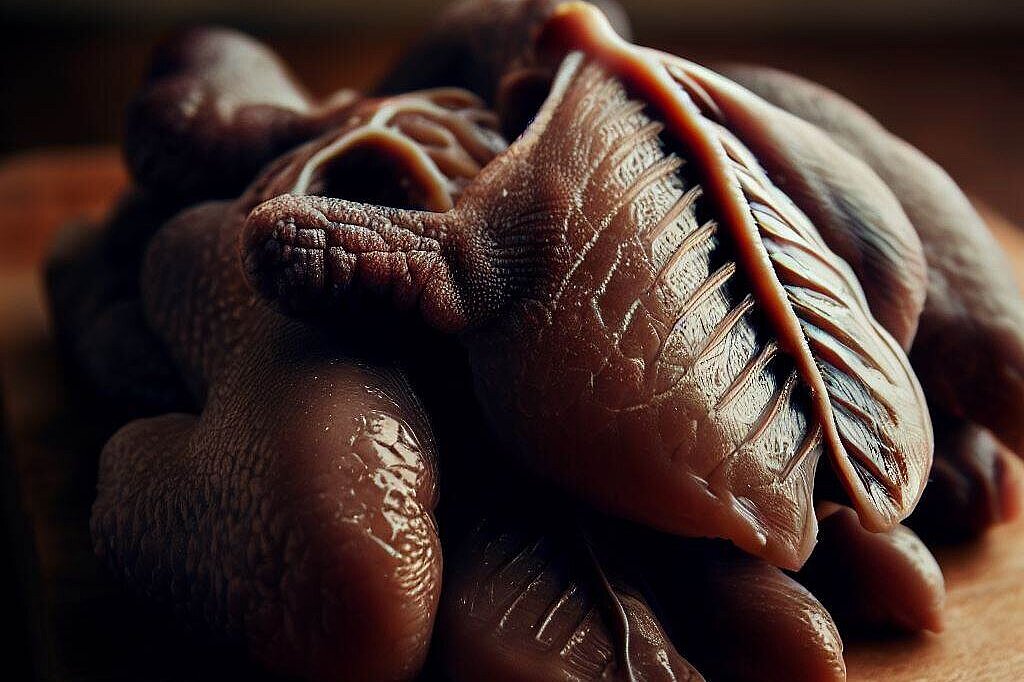Duck lung

Duck lung, often a by-product of processing duck meat, is increasingly finding its way into our dogs' food bags as a healthy and tasty treat. But while this snack can be a source of excitement for dogs, it's worth taking a closer look at both the potential benefits and the possible drawbacks. In this article, we explore what exactly duck lung is and how it can affect the health and well-being of our four-legged friends.
What is duck lung?
Duck lung is a by-product of poultry processing and refers to the lung tissue of the duck. It is valued in animal nutrition for its high protein content and soft texture. Duck lung can be used raw, dried or as part of dog food and treats, with dried duck lung being particularly popular as a healthy and tasty treat.
Benefits of duck lung for dogs
High protein content
Duck lung is rich in proteins, which are essential for the maintenance and repair of body tissues, the production of enzymes and hormones and for a healthy immune system. Protein is an essential part of a balanced diet for dogs and contributes to their overall well-being.
Low fat content
Compared to other meats or animal by-products, duck lung has a relatively low fat content, making it a good option for dogs that are prone to obesity or need a low-fat diet.
Good digestibility
The soft texture and good digestibility of duck lung make it an excellent choice for dogs with sensitive stomachs or older dogs who may have difficulty chewing harder treats.
Source of vitamins and minerals
Duck lung contains important vitamins and minerals that can contribute to dogs' health, including iron, which is important for the formation of red blood cells.
Disadvantages and risks of duck lung for dogs
Quality and origin
As with all animal products, the quality and origin of duck lung is crucial. Products of low quality or dubious origin may contain harmful substances that can be harmful to dogs.
Overfeeding
Despite its low fat content, duck lung should only be fed in moderation to avoid an unbalanced diet and obesity. As with all treats, they should only make up a small proportion of a dog's daily calorie intake.
Allergy risk
Some dogs may be allergic to poultry products. Therefore, when introducing duck lung into a dog's diet, watch for signs of an allergic reaction.
Duck lung can be a healthy and welcome addition to your dog's diet, especially due to its high protein content and easy digestibility. However, it is important to pay attention to the quality of the product and only feed it in moderation to ensure a balanced diet.
If you notice any signs of hypersensitivity or poisoning in your dog, you should see your vet immediately. We are not a substitute for a vet, but we try to be as accurate as possible. Every dog reacts differently and we recommend you get a second opinion or consult your vet if in doubt.
Stay healthy and take good care of your four-legged friend!😊
Similar to Duck lung
Chicken lung is a by-product of poultry slaughter. It consists of the tissue that lines the trachea and bronchi of chickens. Chicken lung has a soft and spongy consistency and a mild taste. It is...
Pheasant lung is, as the name suggests, the lung of the pheasant, a game bird that is popular both for its tasty meat and for hunting. In the context of dog nutrition, pheasant lung is a by-product...
Quail lung, the respiratory organ of the quail, is a light, porous tissue that is rich in protein and low in fat. In animal nutrition, it is often dried or processed into a fine powder for use as a...
Rabbit lung is a by-product of rabbit slaughter. It is the organ responsible for respiration. Rabbit lung is rich in protein and has a low fat content. It also contains iron, zinc and vitamin B12....



